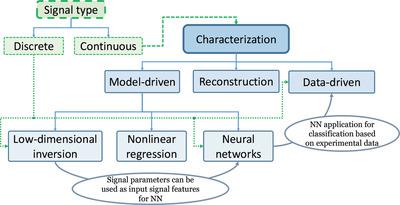当前位置:
X-MOL 学术
›
Laser Photonics Rev.
›
论文详情
Our official English website, www.x-mol.net, welcomes your
feedback! (Note: you will need to create a separate account there.)
Single‐Particle Characterization by Elastic Light Scattering
Laser & Photonics Reviews ( IF 9.8 ) Pub Date : 2021-01-15 , DOI: 10.1002/lpor.202000368 Andrey V. Romanov 1, 2 , Maxim A. Yurkin 1, 2
Laser & Photonics Reviews ( IF 9.8 ) Pub Date : 2021-01-15 , DOI: 10.1002/lpor.202000368 Andrey V. Romanov 1, 2 , Maxim A. Yurkin 1, 2
Affiliation

|
The field of light‐scattering characterization of single particles has seen a rapid growth over the last 30 years largely due to the progress in measurement and simulation capabilities. In particular, several methods have been developed to reliably characterize various particles, described by a model with several characteristics, with geometric resolution significantly better than the diffraction limit. However, their development has been largely fragmentary, limited to specific experimental set‐ups. To fill this gap, these lines of development are reviewed within a unified framework. While focusing on characterization algorithms themselves, the experimental aspects related to the isolation and measurement of single particles are also discussed. The existing characterization methods are divided into three classes. The widest class is that of model‐driven methods based on solving parametric inverse light‐scattering problems, using a direct inversion of a low‐dimensional mapping, a nonlinear regression, or neural networks. Other classes include model‐free reconstruction methods and data‐driven classification methods. This review is designed to be extensive in including all relevant literature, but the discussion of semi‐quantitative imaging methods, such as tomography or holography‐based reconstruction, is deliberately omitted. Throughout the review the development of various characterization methods is described, they are critically compared, and promising directions of future research are highlighted.
中文翻译:

通过弹性光散射进行单颗粒表征
在过去的30年中,由于测量和模拟功能的进步,单个颗粒的光散射表征领域得到了快速发展。特别地,已经开发了几种方法来可靠地表征由具有几种特性的模型描述的各种粒子,其几何分辨率明显优于衍射极限。但是,它们的发展在很大程度上是零散的,仅限于特定的实验装置。为了填补这一空白,在统一的框架内审查了这些发展路线。在关注表征算法本身的同时,还讨论了与分离和测量单个粒子有关的实验方面。现有的表征方法分为三类。最广泛的一类是使用低维映射的直接反演,非线性回归或神经网络解决模型反光散射问题的模型驱动方法。其他类别包括无模型重建方法和数据驱动分类方法。这篇综述旨在涵盖所有相关文献,但是故意省略了对半定量成像方法(如层析成像或基于全息术的重建)的讨论。在整个综述中,描述了各种表征方法的发展,对其进行了严格的比较,并突出了未来研究的有希望的方向。或神经网络。其他类别包括无模型重建方法和数据驱动分类方法。这篇综述旨在涵盖所有相关文献,但是故意省略了对半定量成像方法(如层析成像或基于全息术的重建)的讨论。在整个综述中,描述了各种表征方法的发展,对其进行了严格的比较,并突出了未来研究的有希望的方向。或神经网络。其他类别包括无模型重建方法和数据驱动分类方法。这篇综述旨在涵盖所有相关文献,但是故意省略了对半定量成像方法(如层析成像或基于全息术的重建)的讨论。在整个综述中,描述了各种表征方法的发展,对其进行了严格的比较,并突出了未来研究的有希望的方向。
更新日期:2021-02-11
中文翻译:

通过弹性光散射进行单颗粒表征
在过去的30年中,由于测量和模拟功能的进步,单个颗粒的光散射表征领域得到了快速发展。特别地,已经开发了几种方法来可靠地表征由具有几种特性的模型描述的各种粒子,其几何分辨率明显优于衍射极限。但是,它们的发展在很大程度上是零散的,仅限于特定的实验装置。为了填补这一空白,在统一的框架内审查了这些发展路线。在关注表征算法本身的同时,还讨论了与分离和测量单个粒子有关的实验方面。现有的表征方法分为三类。最广泛的一类是使用低维映射的直接反演,非线性回归或神经网络解决模型反光散射问题的模型驱动方法。其他类别包括无模型重建方法和数据驱动分类方法。这篇综述旨在涵盖所有相关文献,但是故意省略了对半定量成像方法(如层析成像或基于全息术的重建)的讨论。在整个综述中,描述了各种表征方法的发展,对其进行了严格的比较,并突出了未来研究的有希望的方向。或神经网络。其他类别包括无模型重建方法和数据驱动分类方法。这篇综述旨在涵盖所有相关文献,但是故意省略了对半定量成像方法(如层析成像或基于全息术的重建)的讨论。在整个综述中,描述了各种表征方法的发展,对其进行了严格的比较,并突出了未来研究的有希望的方向。或神经网络。其他类别包括无模型重建方法和数据驱动分类方法。这篇综述旨在涵盖所有相关文献,但是故意省略了对半定量成像方法(如层析成像或基于全息术的重建)的讨论。在整个综述中,描述了各种表征方法的发展,对其进行了严格的比较,并突出了未来研究的有希望的方向。











































 京公网安备 11010802027423号
京公网安备 11010802027423号